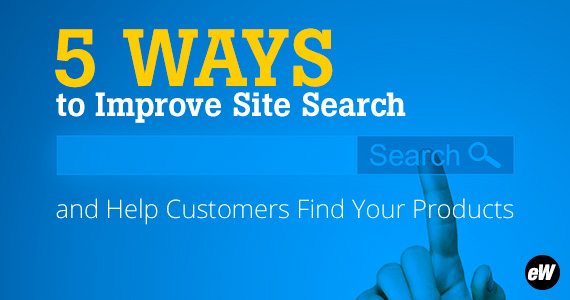 What makes shopping at some of the major e-commerce sites seem so intuitive? How can these sites often anticipate your next query? The answer lies in the sites’ ability to use technology to both engage users and plug their products. They have taken steps to make site searches easy for you, and profitable for them. How can your e-commerce site do the same? Here are five easy steps to help customers find products they want to buy on your site.
What makes shopping at some of the major e-commerce sites seem so intuitive? How can these sites often anticipate your next query? The answer lies in the sites’ ability to use technology to both engage users and plug their products. They have taken steps to make site searches easy for you, and profitable for them. How can your e-commerce site do the same? Here are five easy steps to help customers find products they want to buy on your site.
Step 1: Include site search. If shoppers have found their way onto your site, this is a great way to keep them there. Site search engines allow them to fine-tune their original search or easily browse your other products. Let’s say a shopper found your site after Googling “Dodgers baseball cards.” If she decides she’s also in the market for Pirates or Red Sox cards, she can easily and quickly find those pages via your site search without ever leaving your store.
Step 2: Make sure your site search box is prominent. If you’re offering site search, make it easy for shoppers to locate the search box. You don’t want them to waste precious minutes seeking it out when they could be perusing your products! Don’t skimp on size, and put it at or close to the top of the main page, not tucked in a corner.
Step 3: Make searches quick — and include auto-completion. You’ve enjoyed these benefits if you’ve ever searched on Amazon or eBay. Site search features work best for you when they produce immediate results, so help move those results along even faster! Check that your back-end operations are up to the task with the right server size and amount of memory, or look into cloud-based hosted search services. Similarly, make use of auto-completion – the ability for search engines to “guess” at what you’re typing before you’ve even finished; i.e., “Dodgers baseball ” could bring up “cards,” “clothing,” and any number of other results of products that you could be selling. For your customers, auto-completion offers reassurance that others have searched for the same item, which can psychologically help cement a sale. If your Site Search engine doesn’t include an auto-completion module, you can buy and install it separately.
Step 4: Pay attention to what shoppers are searching on your site. Use Google’s Keyword Tool to view search volume in order to get a feel for what shoppers are seeking. These results can help your e-commerce site in numerous ways, including product development and sourcing, and tweaking your site’s search mechanism. Are they searching for “1977 Dodgers cards?” It could be time for you to up your inventory of that particular team.
Step 5: Learn how to promote your products via search context. Let the power of your site search function spark shopper interest in as many of your products as possible. For example, a search of “Dodgers baseball cards” could potentially auto-complete to “Dodgers shirts” – perhaps inspiring an impulse purchase. Do all you can to understand how to best leverage these tools, and you may be surprised with the results.
The Bottom Line
Seeking more sales? Site search is a feature shoppers appreciate, and it’s one that savvy consumers have largely come to expect. Including it on your e-commerce site can help your sales by producing faster results and keeping your visitors engaged on your site, instead of a competitor’s.






